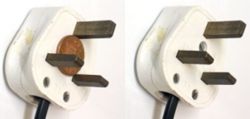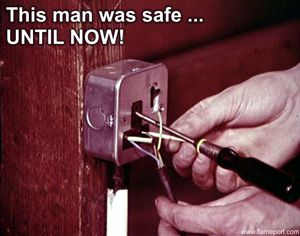UK 13A Plugs (BS1363 Plug)
The information here is not of any use if you want to replace a plug or a fuse. Purely for display purposes only, not suitable for children, do not try this at home.
Sleeved Pins - or lack of
 All plugs sold in the UK in the last two decades have sleeved pins. Half of the live and neutral pins are insulated with plastic, so that a plug partially inserted into a socket does not become a shock risk. If someone put their fingers behind the plug and the pins were not insulated, they would receive an electric shock.
All plugs sold in the UK in the last two decades have sleeved pins. Half of the live and neutral pins are insulated with plastic, so that a plug partially inserted into a socket does not become a shock risk. If someone put their fingers behind the plug and the pins were not insulated, they would receive an electric shock.
All plugs with unsleeved pins were probably thrown away years ago.
Except for this one. This nasty example has unsleeved pins, all of the metal components are completely loose even when the lid is on, the flex grip is made from some kind of compressed paper and it has the remains of an ancient label on the lid.
Penny Plug
 DANGER! Do NOT do this! . Another (probably untrue) explanation for introducing sleeved pins is that it prevents someone from 'pennying' the plug. This was an exceptionally dangerous practice which involved placing a 1p coin between the plug pins, so that when plugged in it would overload the circuit and cause the fuse in the main fuse box to blow.
DANGER! Do NOT do this! . Another (probably untrue) explanation for introducing sleeved pins is that it prevents someone from 'pennying' the plug. This was an exceptionally dangerous practice which involved placing a 1p coin between the plug pins, so that when plugged in it would overload the circuit and cause the fuse in the main fuse box to blow.
Either that or the plug and socket would explode in a ball of fire, causing serious injury to anyone in the vicinity.
Fuse Bypass
DANGER! Do NOT do this! . Other unwanted and dangerous efforts include wrapping the fuse in aluminium foil - putting lives at risk rather than buying a new fuse for 10p. Or just replace the fuse with a solid piece of metal, a short length of 5mm studding fits perfectly. Just as bad, get a plug like the shoddy one above, throw away the live pin and replace it with a neutral pin from another plug, creating an unfused plug. No doubt that the machine on the other end was a heavy duty welder, which should have been permanently wired to its own circuit.
Widowmaker
DANGER! Do NOT do this! .Sadly still seen even today, this is another dangerous bodge. Some items of equipment, namely dimmer racks as used in stage/theatre lighting, require more than 13A to operate. They should be connected to dedicated 16A, 32A or 63A rated outlets.
Unfortunately, some individuals can't be bothered with all that, so they get two 13A plugs and attach both of them to the end of the flex, in a Y arrangement. Since Y flexes are not a standard item, large amounts of insulation tape complete the mess. Then, plug both in and 26A can be drawn from the circuit before fuses blow.
This has several problems. First, a twin socket outlet is not rated at 26A, it is at best 20A shared between the two sockets, and for prolonged periods may be even less. This means the socket overheats.
Second, if only one plug is inserted, the pins on the other one are live, injuring or killing anyone that they might come into contact with.
The same name and same problem applies to a flex with a plug on each end. Plug one end in and the pins at the other end are live. Why would anyone want that? Easy - so they can attach their portable generator to the house wiring during a power cut. Deadly dangerous for several reasons.
Longer Earth Pin
 The earth pin is longer, as when inserted into a socket it will open the shutters covering the live and neutral holes in the socket. This is a safety feature to prevent other items from being inserted into the socket, such as 2 pin plugs, fingers and so on.
The earth pin is longer, as when inserted into a socket it will open the shutters covering the live and neutral holes in the socket. This is a safety feature to prevent other items from being inserted into the socket, such as 2 pin plugs, fingers and so on.
Some class II (double insulated) appliances have plugs with plastic earth pins. Since they do not require an earth connection, the only function of the earth pin is to open the socket shutters. This is common on mobile phone chargers and other small electronic items.
DANGER! Do NOT do this! . When the modern UK plug was introduced, there were a variety of other incompatible plugs in use. This led to some lazy people not bothering to change the plug, but instead using a screwdriver to open the socket shutters and then shoving the bare wires into the socket. Matchsticks could be used in a futile attempt to secure the wires.
This was extremely dangerous, and the UK Government made a public information film to warn people of the danger.
Yes, some people really did do things like this! Don't be one of them.
Design Variations
Several design variations exist, such as plugs with a T shape earth pin. These are fitted to items such as computers and will only fit into corresponding sockets with T shape holes. These prevent people from plugging their vacuum cleaner into circuits designated for sensitive electrical equipment. They can also be used in office buildings to stop people using electric kettles at their desks and charging their Ipods using company electricity.
Failed Design
One particular design had the lid of the plug as a 'wraparound' style, so that the join between the two halves was not visible when plugged in. Nothing wrong with that, but the flex passed through a round hole in the wraparound lid. This meant that the flex had to be passed through this hole before the plug was wired. You normally discovered this just after completing the wiring in the plug.
Remembering which colour goes where
One way to remember which colour goes where is to look at the second letter of each word:
bLue - Left
bRown - Right
L/R can also be used for the old colours:
bLack - Left
Red - Right
There is a hidden danger here - Live is NOT on the Left!


